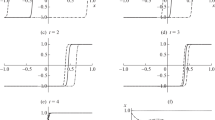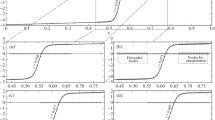Abstract
We present recent results on singularly perturbed reaction-advection-diffusion problems, which are based on a further development of the asymptotic comparison principle. We illustrate this approach applying it to new problems. We also give Theorems stating the existence of periodic solutions with an internal layer, providing their asymptotic approximation and establishing their Lyapunov stability for these problems. We discuss further development of the asymptotic method of differential inequalities (see [1,2,3,4,5]) for the periodic parabolic problems and apply this method to new cases.
Access provided by CONRICYT-eBooks. Download conference paper PDF
Similar content being viewed by others
1 Introduction
We consider periodic solutions with internal layer in the case of non-balanced and balanced advection, and in the case of non-balanced and balanced reaction for the problem
where \(\varepsilon \) is a small parameter, and A, B, \(u^{(-)}(t)\) and \(u^{(+)}(t)\) are sufficiently smooth T-periodic in t functions. We also extend these results for the reaction-advection-diffusion equation
For the initial boundary value problems for this equation we prove the existence of fronts and give its asymptotic approximation including the new case of the blowing-up fronts. The last case we illustrate by the generalised Burgers equation.
2 Periodic Problems
We present recent results on general scheme of asymptotic method of differential inequalities for periodic reaction-advection-diffusion equations (see [2] and references therein) and apply it to some important for applications cases of problem (1).
2.1 Periodic BVP with Balanced Reaction
We illustrate our approach applying it to the following variant of the Eq. (1):
This is subject to the following conditions:
- (\(A_1\)):
-
the reduced equation \(F(u,x,t,0)=0\) has exactly three roots \(\phi ^{(-)}(x,t)\), \(\phi ^{(0)}(x,t)\), and \(\phi ^{(+)}(x,t)\), such that \(\phi ^{(-)}(x,t)<\phi ^{(0)}(x,t)< \phi ^{(+)}(x,t)\);
- (\(A_2\)):
-
\(F_u(\phi ^{(\pm )},x,t,0)>0\) and \(F_u(\phi ^{(0)},x,t,0)<0\).
For the case of a balanced reaction we have
- (\(A_3\)):
-
\(I(x,t):=\int ^{\phi ^{(+)}(x,t)}_{\phi ^{(-)}(x,t)} F(u,x,t,0)du \equiv 0\).
To construct the formal interior layer asymptotics, we use the anzatz (a similar treatment one can find in [1,2,3,4,5])
where the terms are the series in \(\varepsilon \), and the location of the interior layer \(x^*(t,\varepsilon )\) is unknown from the beginning and is defined by \(C^1\)-matching procedure \(x^*(t,\varepsilon )=x_0(t)+\varepsilon x_1(t)+\varepsilon ^2 x_2(t)+ \cdots \). The main term of the layer location is a solution to the problem
where \(H(x_0,t)\) is defined by input data. We assume
- (\(A_4\)):
-
the problem for \(x_0(t)\) has a solution.
For the next terms of the layer location we have the equation
and we assume
- (\(A_5\)):
-
\(\frac{1}{T}\int _{0}^{T}\frac{d(t)}{m(t)}dt<0\).
Theorem 1
Suppose \((A_1)-(A_5)\) are valid. Then there exists the contrast structure type solution \(u(x,t,\varepsilon )\), \(|u(x,t,\varepsilon ) - U_n(x,t,\varepsilon )|<C\varepsilon ^{n+1}\), which is asymptotically stable in the sense of Lyapunov with the local domain of stability \([\alpha _1, \beta _1]\), where \(U_n(x,t,\varepsilon )\) is the n-th order partial sum of the constructed approximation and \(\alpha _1, \beta _1\) are lower and upper solutions constructed by the modification of \(U_1(x,t,\varepsilon )\) according to general scheme of asymptotic method of differential inequalities; see [1,2,3,4,5].
3 Initial Boundary Value Problems with Fronts: Motion and Blow-Up
We present recent results for some classes of IBVP (initial boundary value problem) where we investigate moving fronts by using the developed comparison technique. For these initial boundary value problems we prove the existence of fronts and give their asymptotic approximation. We prove that the principal term, describing location of the moving front, is determined by the initial value problem
where \(x_{00}\) is an initial location of the front and \(V(x_0)\) is a known function, defined by the input data. We proved that the Lyapunov stability of steady points of Eq. (2) determine the Lyapunov stability of stationary solutions with interior layer of the IBVP. We also proved that under some conditions the blow-up of the solution problem (2) determine the blow-up of the interior layer solution of the IBVP.
3.1 Reaction-Advection-Diffusion Equations
We illustrate our results considering the problem
Let us assume
- \((H_1)\) :
-
equation \(A(u,x)\frac{du}{dx} + B(u,x)=0\) with initial condition \(u(0) = u^0\) has solution \(u = \varphi ^l(x)\), and with initial condition \(u(1) = u^1\) has solution \(u = \varphi ^r(x)\), such that for all \(x\in [0,1]\) \(\varphi ^l(x) < \varphi ^r(x)\), \(A(\varphi ^l(x),x) > 0\), \( A(\varphi ^r(x),x) < 0\) hold;
- \((H_2)\) :
-
\( I(x) := {\int \limits }^{\varphi ^r(x)}_{\varphi ^l(x)} A(u,x)du >0\);
- \((H_3)\) :
-
the initial value problem
$$\begin{aligned} \frac{dx_0}{dt} = \frac{I(x_0)}{\varphi ^r(x_0) - \varphi ^l(x_0)},\quad x_0(0) = x_{00}, \end{aligned}$$where \(x_{00}\) is the initial location of the front, has solution \(x_0(t):[0;T] \rightarrow [0,1]\) such that \( x_0(t) \in (0,1)\) for all \( t \in [0,T]\).
The main result for this problem is the existence and asymptotic approximation theorem of the moving front with the principal term of the front location \(x_0(t)\).
3.2 Burgers Type Equation with Blow-up of the Solution
The following Burgers type equation exhibits the blow-up of the front type solution:
Examples of calculations are in Fig. 1.
References
V.F. Butuzov, N.N. Nefedov, L. Recke, K.R. Schneider, Periodic solutions with a boundary layer of reaction-diffusion equations with singularly perturbed Neumann boundary conditions. Int. J. Bifurc. Chaos 24, 14400191–14400198 (2014)
N. Nefedov, Comparison principle for reaction-diffusion-advection problems with boundary and internal layers. Lecture Notes in Computer Science, vol. 8236, pp. 62–72 (2013)
N.N. Nefedov, E.I. Nikulin, Existence and stability of periodic contrast structures in the reaction-advection-diffusion problem. Russ. J. Math. Phys. 22, 215–226 (2015)
N.N. Nefedov, L. Recke, K.R. Schnieder, Existence and asymptotic stability of periodic solutions with an interior layer of reaction-advection-diffusion equations. J. Math. Anal. Appl. 405, 90–103 (2013)
A.B. Vasileva, V.F. Butuzov, N.N. Nefedov, Singularly perturbed problems with boundary and internal layers. Proc. Steklov Inst. Math. 268, 258–273 (2010)
Acknowledgements
This work is supported by RFBR, pr. N16-01-00437, and by RFBR-DFG, pr. N14-01-91333.
Author information
Authors and Affiliations
Corresponding author
Editor information
Editors and Affiliations
Rights and permissions
Copyright information
© 2018 Springer Nature Switzerland AG
About this paper
Cite this paper
Nefedov, N. (2018). Fronts in Reaction-Diffusion-Advection Problems: Periodic Motion and Blow-Up. In: Korobeinikov, A. (eds) Extended Abstracts Summer 2016. Trends in Mathematics(), vol 10. Birkhäuser, Cham. https://doi.org/10.1007/978-3-030-01153-6_8
Download citation
DOI: https://doi.org/10.1007/978-3-030-01153-6_8
Published:
Publisher Name: Birkhäuser, Cham
Print ISBN: 978-3-030-01152-9
Online ISBN: 978-3-030-01153-6
eBook Packages: Mathematics and StatisticsMathematics and Statistics (R0)





